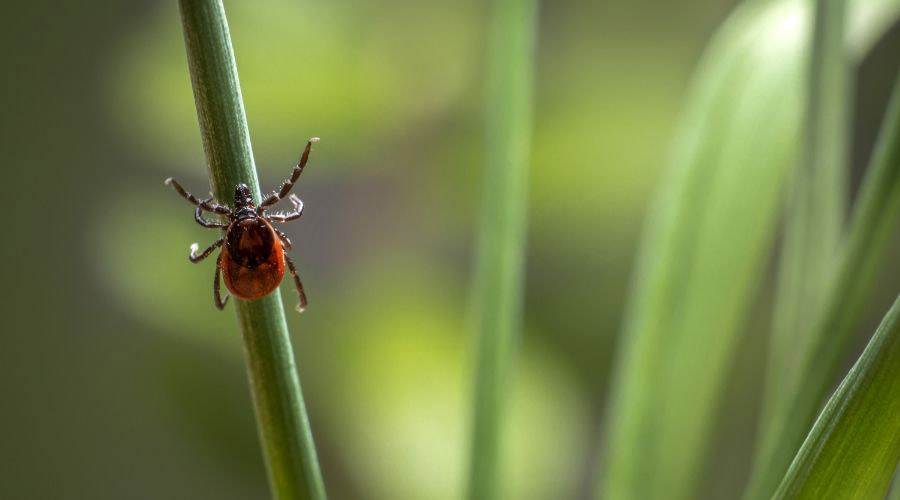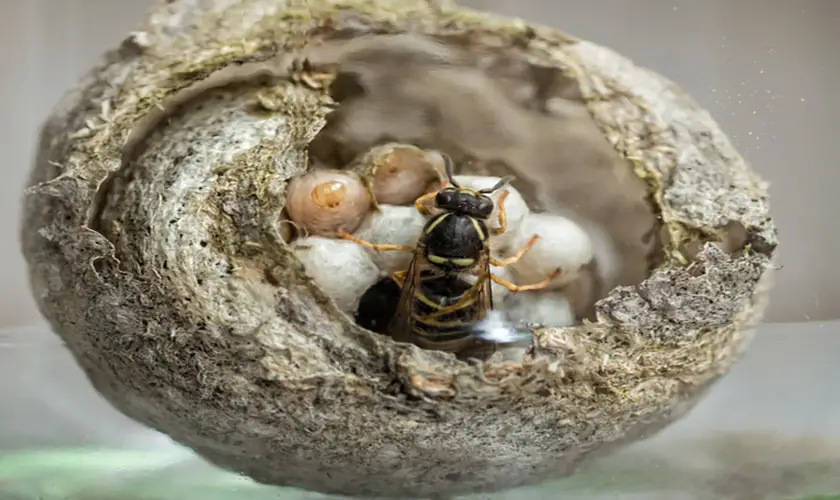
Ticks are parasitic arachnids that feed on the blood of mammals. This is an awful truth to anyone, and it is a living nightmare for people with arachnophobia.
Egg, larva, nymph, and adult are the four life stages of ticks. They lay their eggs in the fall, eggs hatch in winter, and the larvae emerge to find a host in the spring. They become nymphs and then molt into adults in summer and early fall, although this is not necessarily the same year they hatched. The length of the full life cycle will depend on the tick species.
Ticks feed on mammals when they are larvae, nymphs, and adults, which means that they are active during all the seasons you might like to spend some time outdoors.
The best ways to get ticks out of your yard are:
- Maintain your yard.
- Keep wildlife away from your yard.
- Create gravel, wood chip, or dry mulch barriers.
- Use tick traps.
- Use natural repellents.
- Use chemical repellents.
- Keep ticks off of your pets.
- Call a professional.
Ticks are not just blood-thirsty parasites; they can carry diseases harmful to pets and humans. There are so many reasons why sharing your yard with ticks is unpleasant, but there are also many ways to keep them out.
Get FREE quotes from licensed pest control technicians in your area today. Whether you need spraying for ants, roaches, spiders, ticks, mosquitos, or bed bugs, We Can Help! All technicians are screened, licensed, and insured.
1. Good Yard Maintenance Will Help Keep Ticks Out Of The Yard
Mow The Lawn
Ticks cannot jump or fly; they can only crawl. One of the main methods they employ to attach themselves to a host is climbing up tall grass and grabbing onto the first appropriate mammalian host to walk by. This could be you or your pets.
By keeping your lawn trimmed short, you minimize the chance of ticks climbing onto you, and they are less attracted to short grass as it does not serve their purposes.
Trim Grass And Brush That Grows Up Against Your Property Line
Keep this trimmed short if you have tall grass, brush, or any foliage growing along the outside of your fence line. It attracts ticks and makes it easier for them to grab onto you or your pets when you walk past.
Clean Up Debris
When you mow your lawn, don’t leave the grass clippings on the ground. These provide a moist hiding spot for these parasites. A good idea is to buy a mower with a catching container for the clippings. Another attraction for ticks is leaf debris, particularly if it is moist or decaying.
Compost piles are attractive to ticks. So, instead of having an open compost heap, use a specialized composting bin, or create a tick-repelling barrier around your open compost heap. Ensure that the compost stays hot because ticks do not like the heat.
Although they are not debris, ground cover plants can attract ticks, so you should restrict your use of groundcovers like creeping juniper, mondo grass, and pachysandra. These plants benefit your garden in many ways, so you may not want to avoid them entirely. A good compromise is to avoid planting them in the areas most used in the yard, such as play areas for children, gazebos, and other places. Avoid planting them along the perimeter of your property.
Stack Wood Piles Properly
Untidy wood stacks provide dark hiding places that attract ticks, especially if the wood is not completely dry. Ensure to stack the wood neatly and put it somewhere out of the rain or in a place where the sun will easily dry it after rain.
Don’t Overwater Your Yard
A flooded garden will attract ticks, so avoid overwatering your lawn and beds, and also watch out for areas of poor drainage where water can collect.

2. Keep Wildlife And Strays Away From Your Yard
Fences And Walls
Wildlife, such as mice and deer, and stray animals are common tick hosts, and they can bring ticks to your property. By installing fences or walls, you can prevent these animals from coming into your yard or coming into contact with your animals.
Keeping Deer Away
Deer are common hosts for multiple species of ticks. If they come near or into your yard, they can drop ticks, which becomes a problem for you and your pets. As mentioned before, you can build fences or walls to keep the deer out, but other deer-deterring options exist.
Deer are attracted to certain plants. They like apples, plums, sorghum, alfalfa, red clover, chicory, and more. You should avoid planting these near fence lines or try not to plant them at all. You can uproot them if they are already growing in your yard and are not too attached to them.
Certain plants repel deer. They do not like to eat fuzzy, hairy, or prickly plants such as blue tops, poppies, lamb’s ears, Siberian bugloss, and thistles. They are also repelled by aromatic plants like hyssop, catmint, rosemary, wormwood, and Russian sage. Some plants are even toxic to them, so they will avoid coming near and eating them. These deer-toxic plants include daffodils and most varieties of fern.
You can also use purchased or homemade deer repellent sprays.
Keep Mice And Other Rodents Out Of Your Yard
Fences and walls are a less effective barrier against mice and other rodents, but as these critters carry ticks, you will want to keep them out of your yard. Ensure that there are no convenient holes in your fence line or walls that would make it easier for mice to enter your yard.
The good news is that one of the best methods for keeping mice out of your yard is keeping it tidy and free of debris and stacking your woodpiles neatly. It takes time and effort to maintain your yard, so it is nice to know it has a double benefit for your quest of getting rid of ticks. Another method is to remove food sources like birdseed, pet food, and open trash cans from your yard.
They can also be effective rodent-deterrents if you have terriers or other ratting dogs or cats.
3. Create A Barrier That Ticks Will Not Cross
While fences and walls are not guaranteed to keep ticks out, certain ways to create barriers will deter ticks. Ticks do not like walking on gravel, wood chips, and dry mulch; they find it difficult and avoid it.
Knowing this, you can create a barrier to keep ticks out of your yard by laying a one to three-foot-wide gravel, dry wood chip, or dry mulch line along your property’s perimeter. You can also lay gravel paths in other areas of your yard, making it difficult for ticks to move around your yard and reach your house.
A further benefit of gravel barriers is that they soak up heat from the sun, and ticks avoid heat.
4. Use Tick Traps To Keep Them Out Of Your Yard
Ticks are attracted to carbon dioxide emissions. It is how they know when a viable host is nearby. You can use this attraction to trap them.
You can construct a trap using a block of dry ice in a bowl. Cover a sheet of cardboard or wood with a sticky substance such as petroleum jelly, carpet tape, or any other double-sided tape. Put the sticky sheet out in your yard and place the bowl of dry ice at the center of the sheet. Dry ice, or solid carbon dioxide, “unfreezes” into its gaseous state, and ticks will be drawn to these emissions and become stuck to the cardboard or wooden sheet.
Another method that relies on dry ice is to dig a hole in your yard and put a smooth-edged tub into the hole. Put some dry ice into the tub and wait for the ticks to fall. The smooth edges make it impossible for them to climb out again. You can then dispose of the parasites however you want to.
Although simple, these trapping methods are effective, and you can trap many ticks simultaneously. But don’t leave the dry ice unattended if you have children or pets.

5. Use Natural Tick Repellents To Keep Them Out Of Your Yard
Plants That Repel Ticks
If you want to keep ticks out of your yard, you can consider planting chrysanthemum cinerariaefolium, also known as pyrethrum. If the name pyrethrum sounds familiar to you, it is because these flowers are used to produce pyrethroid insecticides. So, by planting these in your yard, you are equipping yourself with a natural pesticide.
Other tick-repelling plants include:
- Beautyberry
- Catnip
- Eucalyptus
- Garlic
- Lavender
- Lemongrass
- Mint
- Pennyroyal
- Rosemary
- Rue
- Sage
- Wormwood
Some of these plants, such as lemongrass and rue, are repellent and toxic to ticks. There is also an overlap between the plants that repel ticks and those that repel deer, so this is a bonus. A further benefit to these plants is that they keep various insects away, including mosquitoes.
If you have pets, you need to beware, as some of these tick-repelling plants can be toxic to your pets.
Natural Oils That Can Be Used In Repellent Sprays
If you are an avid essential oil user, you probably already have many tick-repellent oils in your arsenal. In homemade repellent sprays, you can use cedar, citronella, eucalyptus, lavender, peppermint, and tea-tree essential oils. Remember that you will need to add an emulsifier or a solubilizer to the spray for the oil to be dispersed in the water. A good and easily available option is adding dish soap to the spray.
You can’t spray every inch of your yard with these homemade tick repellents. The task would be tedious, and essential oils are expensive. Instead, target your perimeter. Spray your fence or wall every few feet. Concentrate on the sides that abut wooded areas or fields. You will need to re-spray relatively often and after it rains.
You also need to remember that if you plan to use essential oil sprays on your skin, you should not use dish soap as a solubilizer, and you need to dilute the essential oils, or they can burn your skin.
Other Natural Tick Repellents
Apple cider vinegar and diatomaceous earth have also been reported as effective tick repellents. Spray the apple cider vinegar or sprinkle diatomaceous earth around your fence line.
You can also use citrus fruits. Boil about two cups of chopped citrus fruits (lemons, oranges, grapefruits, limes, etc.) in two cups of water for a couple of hours, but don’t let all of the water evaporate because this is what you will use in your spray bottle.
Chickens and guinea hens eat ticks. If you are not opposed to owning a few of these birds and letting them wander around your yard, they have proven effective in reducing the tick population. Of course, they can pick up ticks, so it is important to keep them healthy.
6. Use Chemical Tick Repellents To Keep Them Out Of Your Yard
You can use chemicals to keep ticks away from your yard. However, because of their hazardous nature, there are certain precautions that you need to take and guidelines to which you need to adhere to use them.
It would be best to consider who will be exposed to pesticides other than the ticks. Suppose you have children or other at-risk family members (older people, immunocompromised people, pregnant women, or people with allergies). In that case, you must select the pesticide and apply it carefully. Pets and non-pestilential wildlife are also at risk from pesticides.
There may be rules in your area governing pesticide usage. For example, pesticides may be prohibited if you live near a natural water supply because of the potential risk of water contamination. Other situations where pesticide usage may be prohibited are living near organic farms or conservation areas.
Contact your local health officials, agricultural officials, or even the CDC for guidance on what to use, how to use it, and if you can use it.
7. Keep Ticks Out Of Your Yard By Keeping Them Off Your Pets
Your dogs and cats can carry ticks into your yard, but where do they get them?
Unless you keep your cat indoors, they will leave your yard. Your cat can easily pick up ticks if you live near fields or wooded areas. Even if you live in the suburbs, ticks are around. Dogs will usually only leave the yard when they go with their owners, but long grass on the side of the road or busy dog parks can be a source of ticks.
If other people walk their dogs past your fence, ticks can drop off and climb onto your dog (who will probably be standing right at the fence line barking). If your friends bring their dogs over for a visit, or you hire a dog-walker who walks dogs from multiple homes simultaneously, ticks can climb onto your dog.
To prevent your dog from picking up ticks, avoid walking them in or near long grass, avoid dog parks entirely (if your dog has other safe places to run around), or at least when they are busy. Also, try to avoid poorly maintained dog parks. Don’t let your friends bring their dogs over unless they have taken the proper precautions to protect them against ticks.
Put a tick collar on your dogs and cats and replace the collars as often as recommended. You can also use specialized tick repellent sprays for pets. Please speak to your veterinarian about the safety of using sprays on your dog (they might be allergic) and the safety of using them in conjunction with the tick collars. Re-spray as often as directed.
Regularly inspect your dogs and cats for ticks. If they pick up a tick, it is best to remove it immediately. Not only can it hurt your pet, but it may also be a pregnant female tick, which can then lay her eggs in your yard, and come springtime, you will have a tick problem.
If you pick up a stray animal, keep them separate from your pets until they have been sprayed for ticks.

8. Call In The Professionals
If you don’t feel you can effectively manage your tick problem, you can always hire a professional. These people know the best ways to exterminate ticks and can give you tips on maintaining a tick-free yard. Professionals also usually know which chemical pesticides can be used and how to use them correctly.
Veterinarians and pet store owners can also advise you on keeping ticks away.
Reasons Why It Is Important To Get Ticks Out Of The Yard
Anaplasmosis
Anaplasmosis is a tick-borne disease caused by the Anaplasma parasite. It affects the red blood cells and is symptomized by fever, rash, bloody urine, and anemia. It affects humans and ruminants (cows, goats, and sheep).
Babesiosis
This tick-borne disease is caused by either the Babesia or Theileria eukaryotic parasites. Symptoms include fatigue, fever, and hemolytic anemia (it breaks down red blood cells). It can occur simultaneously with other tick-borne diseases. It is common in humans and dogs but rare in cats.
Colorado Tick Fever
Colorado tick fever is caused by the Coltivirus and is another tick-borne disease. Symptoms include two-stage fever, headaches, ocular pain, light sensitivity, abdominal pain, nausea, vomiting, and rash. This viral infection can be serious, especially in children, and may require hospitalization. Humans and dogs can both get Colorado tick fever.
Ehrlichiosis
The Ehrlichia and Anaplasma bacteria cause ehrlichiosis. It is transmitted by ticks and destroys white blood cells. It can affect humans but is more common in animals such as dogs.
Lyme Disease
Lyme disease is one of the most well-known tick-borne diseases because it is the most prevalent of these diseases in the USA. It can affect humans and dogs, and there is also some evidence that some cats are at risk.
It is caused by the Borrelia bacterium, which transmits through ticks. Lyme disease symptoms include the unmistakable bulls-eye rash, fever, headaches, and fatigue. If left untreated, lyme disease can cause partial paralysis, neck stiffness, severe headaches, joint pain, and cardiac palpitations.
Relapsing Fever
Relapsing fever is also caused by the Borrelia bacterium and spread by soft-bodied ticks. It causes fever, headaches, nausea, muscular pain, and joint pain. It is called relapsing fever because the symptoms disappear and recur in a cyclic pattern if left untreated. Humans, dogs, and cats can all get a relapsing fever.
Spotted Fever
There are many variations of spotted fever, all caused by the bacterium genus Rickettsia and transmitted by ticks. Symptoms include fever, nausea, vomiting, muscular pain, rash, and headache. Spotted fever affects the lining of blood vessels. It is severe and may require hospitalization. Some people have even gone blind, deaf, or lost limbs because of this infection. Humans, dogs, and cats can all get spotted fever.
Tularemia
This tick-borne disease is caused by the Francisella tularensis bacterium. It can cause fever, skin ulcers, inflammation, and enlargement of the lymph nodes.
Most Common Human-Biting Ticks And Their Prevalence In The USA
If you are struggling with a tick infestation, it is helpful to know what type of tick you are dealing with and which diseases you might be exposed to if it bites you.
Dermacentor variabilis, or the American Dog Tick, is found in most areas east of the Rocky Mountains. They are also found along the Pacific coast, but only in limited areas. American Dog Ticks can transmit Rocky Mountain Spotted Fever and Tularemia.
Ixodes scapularis, or the Blacklegged Tick or Deer Tick is found in most parts of the Eastern USA. Blacklegged Ticks can transmit Anaplasmosis, Babesiosis, Ehrlichiosis, and Lyme Disease.
Rhipicelphalus sanguineus, or the Brown Dog Tick, is found across the USA and worldwide. Brown Dog Ticks can transmit Rocky Mountain Spotted Fever.
Amblyomma maculatum, or the Gulf Coast Tick, is found along the Gulf of Mexico and the Atlantic Coast. Gulf Coast Ticks can transmit Spotted Fever.
Amblyomma americanum, or the Lone Star Tick, is found in the Eastern and Southeastern United States. Lone Star Ticks can transmit Tularemia and Ehrlichiosis.
Dermacentor andersoni, or the Rocky Mountain Wood Tick, is found in the Rocky Mountain States. Rocky Mountain Wood Ticks can transmit Rocky Mountain Spotted Fever, Colorado Tick Fever, and Tularemia.
Ixodes pacificus, or the Western Blacklegged Tick, is found along the USA’s Pacific Coast and in California. Western Blacklegged Ticks can transmit Anaplasmosis and Lyme Disease.
Conclusion
Ticks are worldwide pests, but some areas struggle with tick infestations. Ticks feast on mammalian blood, which makes them unpleasant, but they also carry dangerous and potentially fatal diseases to humans and pets. Keeping them out of your yard is a priority, particularly because they are most active in spring, summer, and fall when you are more likely to be outside.
Ticks love dark, wet environments, so they will seek areas like compost heaps, piles of leaves, wet mulch, and untidy wood stacks. Not overwatering your yard and cleaning up debris will minimize your yard’s attraction to ticks. Maintaining your lawn can reduce the chances of ticks latching onto you or your pets.
If you prevent wildlife from entering or coming near your yard, you can greatly reduce the number of ticks. Remember that pets can bring ticks into the yard if they have access to or contact places outside your yard, so pet care is important. You can also create physical barriers or use traps.
You can use tick repellents; there are several natural substances you can choose if you don’t want to use chemicals. And if the problem calls for a professional exterminator, you can call them in.
With so many ways to get ticks out of your yard, this is a pest problem that you can definitely solve to make your yard safe for you, your family, and your beloved pets.
Get FREE quotes from licensed pest control technicians in your area today. Whether you need spraying for ants, roaches, spiders, ticks, mosquitos, or bed bugs, We Can Help! All technicians are screened, licensed, and insured.








